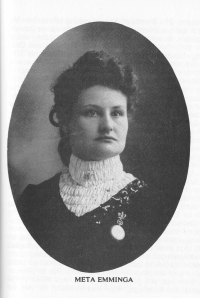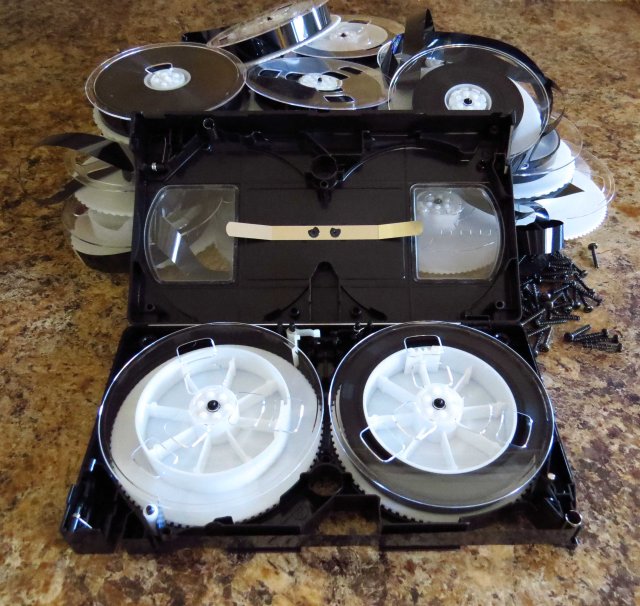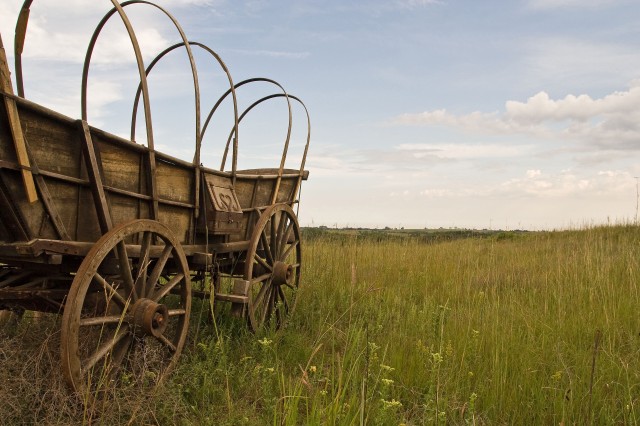Golden New Era
Golden, Illinois
April, 22, 1937
Note: if you are an Antique’s Road Show or Pickers fan, you will love reading the following 1937 newspaper write-up. Margaret (Meta) Emminga was the granddaughter of Henrich (Henry) Reemts Emminga, the German immigrant you read about in Windmill is of Interest and History of the Old Windmill.
EMMINGA GOODS DRAW CROWDS By Evelyn Austin
 Great interest the last few weeks has been centered upon the possessions of Miss Margaret Emminga, who passed away last month, March 10. It has for some years been known that Miss Emminga, daughter of Harm and Mary (Gembler) Emminga, had quite a penchant for collecting numerous household articles, most of which she purchased in large quantities. These items, most of which were bought in the “boom” years when the family was enormously wealthy, have been accumulated from year to year, and as the possessions increased in number, likewise has the curiosity of townspeople increased.
Great interest the last few weeks has been centered upon the possessions of Miss Margaret Emminga, who passed away last month, March 10. It has for some years been known that Miss Emminga, daughter of Harm and Mary (Gembler) Emminga, had quite a penchant for collecting numerous household articles, most of which she purchased in large quantities. These items, most of which were bought in the “boom” years when the family was enormously wealthy, have been accumulated from year to year, and as the possessions increased in number, likewise has the curiosity of townspeople increased.
Now that the estate is being settled, these articles have been unpacked by relatives, and for once we are able to say that “gossip has not exaggerated the quantity of goods on hand.” Articles, both in the necessity and luxury class, were packed in every nook and cranny of the large twelve-room house, formerly owned by the Emminga family, and which was purchased five years ago by Jake Zimmerman, a nephew. It took weeks to unpack, sort, and list the possessions, which were moved, one truckload after another, to the Windmill and Steam Mill nearby, and were arranged for sale. Two big rooms in the Steam Mill were required for the stock, which is piled to the ceiling in each room, with just enough space for passage ways. The furniture and larger articles are stored in the Windmill and are to be offered for sale at public auction this coming Saturday.
Miss Emminga’s mother, Mrs. Ettje Mary Emminga is still living, being eighty-three years of age. Ehme R. Gronewold has been appointed by the court as conservator of her affairs, and Menhard J. Buss is administrator of the daughter’s estate. These two men are in charge of the disposal of the property.
They were greatly surprised when they learned the extent of her collection, unusual because everything was bought at retail, was never used, and complete enough to stock a general store. It is estimated she spent $10,000 on her purchases.
For the past two weeks dealers have been inspecting such merchandise as hardware, yard goods, canned goods, china, glassware, silverware, wearing apparel, fancy work, antiques, furniture, rugs, pottery, etc. In many cases the goods were sold in bulk lots to such men. While we were touring the place Thursday afternoon of last week, a Quincy merchant was present, and we were told he had offered $500 for the bolts of new material which were on display. This offer was refused, however, and a deal was finally consummated, in which the man purchased the goods at a certain price per yard. Two days were required to measure and tag the goods. Most of which were whole bolts from which no cloth had ever been taken. Most of the prints were of obsolete patterns indicating Miss Emminga had secured them many years before.

Illustrated by A. Bruce Loeschen
Several Quincy and Macomb dealers were on hand looking and purchasing desired wares. In the collection are several pieces of lovely furniture and pottery, which were purchased by Mr. Emminga, while he was in Jerusalem on his tour of the Orient in 1910.
In this group is a Jerusalem writing desk, the top being of beautiful light and dark wood inlay, together with several small matching chests, a revolving top table, etc. One of those in charge informed us they had been offered $600 for the desk alone, but the offer was refused. A similar but larger desk was taken by Mrs. John Emminga (Meta’s sister-in-law) to California, following the death of her husband in 1934, and we are told that she has written back saying she had taken the desk to a collector, who told her it was a genuine article and undoubtedly worth $10,000. He said it was made in some monastery and had taken several men a lifetime to complete. He also added that its value would be greatly increased if a complete history could be secured of when and by whom it was made. (Gee, sounds to me like an Antiques Road Show appraiser.)
People interested in antique china and glassware have certainly found a Utopia for their search, as we noted in the collection a set of German Blue and White China, a set of Brown and White Cloverleaf Lustre Ware, a set of Haviland China, a set of Green Pattern China, and hundreds of pieces of cut glass and miscellaneous dish ware. Each of the above sets consisted of several hundred pieces, many of which were duplicated.
A large chest of silverware was also found, including a 300-piece set of Rogers 1846 silver in the Berkshire pattern; two sets of Rogers 1847 in a plain pattern; a set of sterling silver; besides several hundred extra tea spoons, table spoons, and odd pieces.
 Box after box of lovely handwork is daily being unpacked, needlepoint, cut work, bead work, tapestries, linens by the hundreds, hand embroidered towels, perhaps a hundred linen towels, dozens of pillow cases and sheets, some initialed; yard after yard of linen table tubing, linen table and luncheon cloths and napkins, lace pieces, embroidered doilies and hand crocheted pieces, more than a dozen bedspreads, several crocheted; dozens of blankets, 48 new comforters, and a number of mattresses.
Box after box of lovely handwork is daily being unpacked, needlepoint, cut work, bead work, tapestries, linens by the hundreds, hand embroidered towels, perhaps a hundred linen towels, dozens of pillow cases and sheets, some initialed; yard after yard of linen table tubing, linen table and luncheon cloths and napkins, lace pieces, embroidered doilies and hand crocheted pieces, more than a dozen bedspreads, several crocheted; dozens of blankets, 48 new comforters, and a number of mattresses.
In another group we find several dozen new rag throw rugs, yards of carpeting, grass rugs, large floor rugs, portieres, draperies, curtains, etc. A large cupboard six-foot high is filled entirely with ladies aprons, never unpacked. One box was opened which contained three suits of women’s silk and wool underwear. It still had the sales slip which showed that it had been purchased at the Kespohl Mohrensecher Store at Quincy on May 2, 1918, and that the three suits had cost $15.75. There were similar slips on other articles. Many of the boxes had prices tags on the outside.
In another section there is enough hardware to stock an ordinary store.
We counted 15 alarm clocks, several parlor clocks, 10 lanterns, trunks, many hundred new kettles, pots and pans, several dozen new brooms, 25 pieces of Pyrex baking glassware, dozens of tin and enamel buckets, whisk brooms, shoe brushes, vegetable brushes, etc., several new ironing boards, six recipe files, a box with 12 new nut crackers and an equal number of boxes of nut picks, knives and other kitchen implements, perhaps a dozen spittoons, crocks, wash tubs, several wash machines, tea kettles, wash pans, dish pans, dust mops, etc.
In another group we find children’s things; several boxes filled with new children’s toys, all alike; blocks and cut-out books, a box of rubber teething rings and rattles, toy soldiers, boxes of celluloid dolls, several cartons of baby talcum, and other baby toilet accessories, a number of complete layettes, etc.
 There is also an assortment of wearing apparel, perhaps 50 pairs of shoes and bedroom slippers, all size, kid gloves, costume jewelry, handkerchiefs and hats.
There is also an assortment of wearing apparel, perhaps 50 pairs of shoes and bedroom slippers, all size, kid gloves, costume jewelry, handkerchiefs and hats.
Mi-lady may find everything for her toilet, numerous dresser sets, some with painted china inlay, others with gold and silver back, perhaps 50 new combs, all sizes and colors and never before unpacked, perfume and atomizers, compacts, powder and puffs.
Perhaps there are a dozen ten-gallon cans filled with lard and cocoa, large boxes of soaps, scouring powders, canned vegetables and fruits, a box containing several hundred new mouse traps, 100 lbs. of coffee, 60 lbs. of tea.
There are perhaps a few thousand other miscellaneous articles. In fact, we can think of no article of which there is not a goodly supply. If you don’t see what you want, “ask” is the motto.
We understand the items of furniture are as numerous. Dozens of chairs, tables, and several complete outfits for each room, will be offered for sale. There is also a lovely Grandfather’s Clock.
We were escorted through the Emminga library by Mrs. Zimmerman. Not being an authority on books and works of literature, it is hard to estimate the value of such a collection. There are perhaps some 5,000 volumes, we are told, including several 15-volume sets of Britannica Encyclopedias, German books, and rare old editions collected by Mr. Emminga during his foreign travels. Such a collection would prove of inestimable value to the library of some college. The most important book in the group is a German Bible 407 years old. It has wooden covers and was brought from Germany. Mr. Emminga was something of a writer. He wrote quite a lengthy account of his travels in foreign countries, in a series of more than 100 articles, which were published in newspaper in this country and Germany. His ancestors went by the name of Emmins. Ubbo Emmins, who lived from 1547 to 1625, was a celebrated historian, whose works are considered as authority in the history of East Freesia, Germany.
In the Emminga library we noted a statue of Martin Luther, several feet high. We understand Miss Emminga at one time promised this statue to the Trinity Lutheran Church of Golden as a gift. If so, it would certainly be placed in an appropriate setting.
A public sale will soon be held, at which time the remaining merchandise will be sold. (next post describes this public sale) It is certain the amount invested ran into thousands of dollars. No single item of any article was purchased, everything being bought in quantity lots. Miss Emminga was able to indulge in this fanaticism, for during the years that she made the bulk of these purchases, her father was president of the Exchange State Bank of Golden and was the wealthiest man in this section of the country.
Anything she wished for, in a material way, she was able to buy. She was quite a learned woman, having studied both in Germany and this country and was a student of music and business matters.
When her father died in December 1915, he provided by will, that all of his real estate which the family occupied at a homestead, and everything on these premises at the time of his death, including his library, should go to his widow and daughter. Everything else which he possessed, both real and personal property, was willed to the son, John Emminga, who was required to pay his mother and sister the sum of $1,000 per year in quarterly payments. The son was not requested to furnish security on his bond of $200,000. The will was dated October 7, 1915.
Thus was Miss Emminga enabled to continue with her unusual hobby, until in more recent years. Due to the Depression and bank failures, her income was more limited, and she was forced to curtail her expenditures somewhat. However, what she purchased was first quality good, as may be seen by the price tag which remains on many of the articles, and has withstood the effects of age exceptionally well. Although it is not expected that the goods can be sold for anywhere near the original purchasing price, it is certain to realize, even at this late date, several thousand dollars. No one knows what she intended to do with her large stock nor the number of years spent in collecting it. It seems that if she saw something that struck her fancy, she would purchase enough to last her the rest of her days.
No monument has been erected for members of the family today. However, those in charge of the estate hope to be able to do this after paying all the expenses.

 Perhaps no monument is needed. We note that in the obituary of Harm H. Emminga, published in 1915, it is said “he needs no monument to perpetuate his memory with hundreds of people, businessmen and farmers, whom he assisted when they were in need and helped them to help themselves. In every movement for good in Golden and vicinity, he was always found among the leaders, regardless of creed or political faith. And that is not all—dozens of acts of charity, philanthropy and benevolence in all parts of the world, he was the author of. He was a man who had traveled much and thought much and was not narrow in his views. He did not make a show of his gifts but wished nothing mentioned of his act and many of these the world will never be known.”
Perhaps no monument is needed. We note that in the obituary of Harm H. Emminga, published in 1915, it is said “he needs no monument to perpetuate his memory with hundreds of people, businessmen and farmers, whom he assisted when they were in need and helped them to help themselves. In every movement for good in Golden and vicinity, he was always found among the leaders, regardless of creed or political faith. And that is not all—dozens of acts of charity, philanthropy and benevolence in all parts of the world, he was the author of. He was a man who had traveled much and thought much and was not narrow in his views. He did not make a show of his gifts but wished nothing mentioned of his act and many of these the world will never be known.”
His memory will be a silent inspiration to those who knew him in this way.
 2013 BLOG (Harm H. EMMINGA)
2013 BLOG (Harm H. EMMINGA)





























































